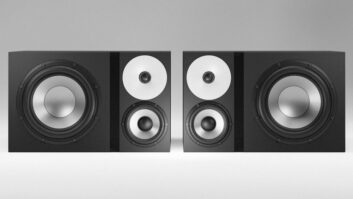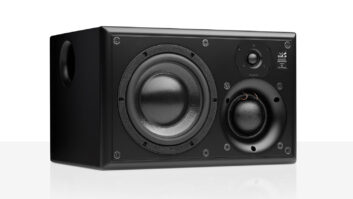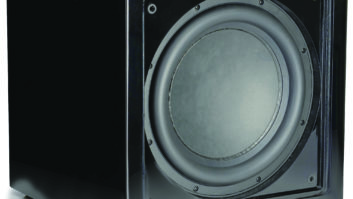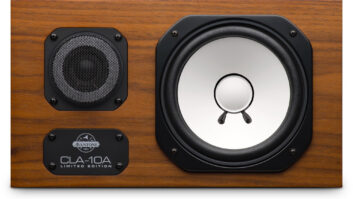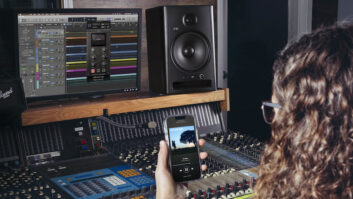Monitors with internal amplifiers offer the luxury of bringing a fairly compact and familiar playback system to every studio in your engineering travels. The surge of 5.1 surround mixes has also created a higher demand for self-powered speakers. To fill this need, Fostex has manufactured an amplified version of the NF-1: the NF-1A. The design is as different as it is efficient.
A NEW LOOKWhen I lifted one of the 25-pound monitors out of its box, I was surprised-not by the weight but by the woofer’s truly unique appearance. I’ve never seen a speaker look anything like this: The cone does not have the usual uniform crater appearance, but is mountainous, with symmetry in the form of a five-pointed star. In addition, the edge of the woofer diaphragm has a novel design that is intended to eliminate unwanted anti-resonance through UDR (Up-Down Roll) construction. Upon looking at the woofer edge, I realize that “UDR” means that the woofer won’t just move in and out, but that it may actually twist a bit as it moves with the sound. The elastic UDR edge may also extend the life of the cone, while minimizing resonances returning to the cone from the entire enclosure.
There are two diffractive reflectors inside each cabinet to minimize internal standing waves. These reflectors are about 6 inches in diameter, and they, too, are pentagonal. Another unique detail is the fact that banana fibers are used in the combination of materials for the woofer, thus the off-yellow color. Fostex chose banana fibers because they are longer than other potentially usable fibers and have a higher level of bonding strength when combined with the base pulp (wood) used to make the diaphragm. The tweeter diaphragm is urethane film laminated over cloth, touting a frequency range of as much as 40 kHz. The tweeter and woofer each receive 60W through bi-amplification.
CONNECTIONS AND CONTROLSThe back panel allows for connection via 11/44-inch phone jack (-10dBV unbalanced input) or 3-pin XLR (+4dBu balanced input, with pin 2 hot). Two level control pots and three switches are recessed for adjustment with a small screwdriver. The recessed design prevents inadvertent changes, although at times I felt these controls were too inaccessible. one level control is for tweeter SPL and is continuously adjustable from -3 to +3 dB, with a detent at zero. The other potentiometer is for overall power output and is also continuous in its travel (not stepped). This presented the only major drawback for me: Without a stepped level control, it is extremely difficult to exactly match left vs. right speaker volumes, especially with the pots as small as they are. Yes, I could set this output at maximum on both the left and the right speakers (more watts equal cleaner sound), but then I end up keeping my mixer output well below unity gain to avoid getting blasted.
The switches for varying the speakers’ EQ give us fewer choices than the potentiometers, but make left-to-right matching more uniform. An on/off Hi-Mid Attenuator drops the 1-to-5kHz range down by 3 dB, centered at 3 kHz. The Low-Frequency Filter Selector, with positions at -3 dB, 0 and +3 dB, affects the frequencies “around 60 Hz.” The High-Frequency Filter Switch adjusts the frequencies “around 10 kHz” up or down by 3 dB. The legends on the back panel are complete in the details of the functions of the controls and jacks, including three frequency response charts pertaining to the EQ switches. Half of the back is covered with the heat sink, which did not get overly hot after leaving the speakers powered up for a week of initial listening.
THE SOUNDI set up the speakers about five feet apart, with the tweeters at ear level. After sending a balanced pair of cables to the XLR inputs, I listened to a variety of music, checking for differences in DAT mixes that I’ve worked on. The EQ controls on the NF-1As were left flat for these early impressions.
The sound of these monitors is pleasing-and natural in the upper frequencies. The NF-1As don’t make the listener jump up shouting “everything sounds so much better through these!” This is as it should be; one does not want to mix with a speaker that is overly bright or makes the mix sound better than it might on a majority of systems. one needs to be able to hear details in the sound, and the versatility of the EQ controls allow one to tailor these monitors to suit their needs.
The bass is quite impressive for this size enclosure. Small speakers often overcompensate for their lack of bass with a design that allows the cabinet to resonate at about 50 Hz, pumping the resonating frequency out in an ugly way. The NF-1As steer clear of that common flaw. The bass sound is wonderful, and it’s amazing how well they play back 808s and other low-frequency elements from hip hop recordings. The kick didn’t pummel me over, and I enjoy the full roundness and uncolored strength of the five-string bass and 808-clear and deep. I never needed to use the +3 setting on the Low Frequency EQ (although it could come in handy to check for the effect of a potentially speaker-damaging mix, as most listeners tend to turn up the bass on their car systems).
While familiar mixes translated quite well through the NF-1As, there is still a hint of difference in the realm of the upper-mids. I heard sidesticks and clave clicks at slightly higher than the level I gave them during the mix, although this was a subtle difference. A tiny bit of hiss also emanates from the speakers when no music plays. However, the NF-1As provide enough clarity and depth to reveal the true textures of various reverbs and effects. The imaging was excellent, especially while listening to an analog recording of a New Hampshire thunderstorm, in which I could hear each raindrop fall in specific locations.
After using these monitors with all the EQ settings flat for a couple long days of overdubbing, I didn’t experience an unusual amount of ear fatigue. Listeners at the session remarked that the NF-1As didn’t sound “near-field,” which meant that they enjoyed the detail and frequency response, even when standing back a bit. My most common complaint about near-field speakers is that the band, while standing at various distances around the control room, does not hear the details that the engineer in the sweet spot hears. The frequency dispersion of this monitor is respectable and maintains an even tone throughout the room.
To recapitulate, I definitely enjoyed the sound of these speakers. (Yes, I wanted to keep them.) Flat response, clear bass and great imaging translate well to other speaker systems, and the extensive high frequency response can be adjusted to your taste. I only wish that the level controls were stepped, instead of continuously variable. In the past, Fostex has provided products that are both affordable and reliable-a difficult combination. That tradition continues with the NF-1A, which at $899 each, offers an excellent alternative to other powered monitors.
Fostex, 15431 Blackburn Ave., Norwalk, CA 90650; 562/921-1112; fax 562/802-1964; www.fostex.com.
